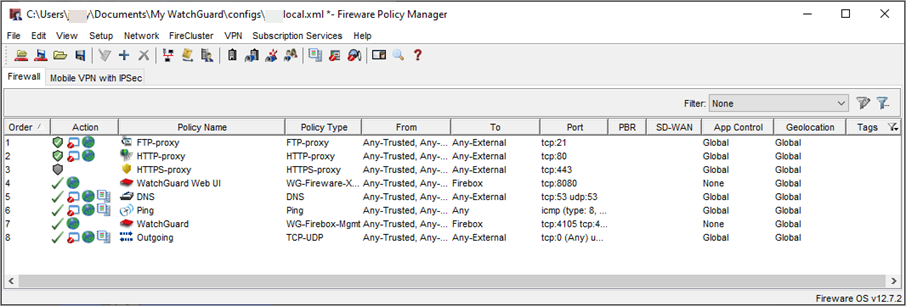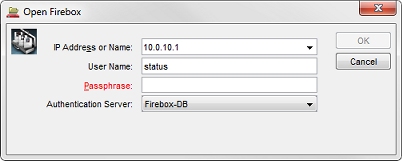Network administrators often have to make changes to their network security policies. Perhaps, for example, your company purchased a new software application, and you must open a port and protocol to a server at a vendor location. Your company might have also purchased a new feature for your Firebox or hired a new employee who needs access to network resources. For all of these tasks, and many more, you must open your configuration file, use Policy Manager to modify it, and then save the configuration file.
Open the Configuration File with WatchGuard System Manager
- Select
Start > All Programs > WatchGuard System Manager 12.x > WatchGuard System Manager 12.x.
The version number in the program path depends on the version of WSM you have installed.
WatchGuard System Manager opens. - Click
 .
.
Or, select File > Connect To Device.
The Connect to Firebox dialog box opens. - From the IP Address or Name drop-down list, type or select the IP address for the trusted interface of your Firebox.
- In the User Name text box, type the user name for a user account that is assigned the Device Monitor role.
The status account is used by default. - Type the passphrase for the user account. Click OK.
The device appears in the WatchGuard System Manager Device Status tab. - On the Device Status tab, select the Firebox. Click
 .
.
Or, select Tools > Policy Manager.
Policy Manager opens with the configuration file that is in use on the selected device. The changes you make to the configuration do not take effect until you save the configuration to the Firebox.

Open a Local Configuration File
You can open configuration files that are saved on any local drive or any network drive to which your management computer can connect.
If you want to use an existing configuration file for a Firebox in a factory-default state, we recommend that you first run the Quick Setup Wizard to create a basic configuration and then open the existing configuration file.
To open a local configuration file:
- In WatchGuard System Manager, click
 .
.
Or, select Tools > Policy Manager.
The Policy Manager dialog box opens. - Select Open configuration file and click Browse.
- Select the configuration file.
- Click Open.
The configuration file opens in Policy Manager.
Open a Configuration File with Policy Manager
To open a configuration file with Policy Manager:
- Select File > Open > Firebox.
The Open Firebox dialog box opens.

- From the IP Address or Name drop-down list, select a Firebox.
You can also type the IP address or host name. - In the User Name and Passphrase text boxes, type the credentials for a Device Monitor (read-only) user account.
- From the Authentication Server drop-down list, select the correct authentication server for the user account you specified.
- If you use an Active Directory server for authentication, the Domain text box appears. Type the domain name of your Active Directory server.
- Click OK.
The configuration file opens in Policy Manager.
You use a Device Monitor user account to monitor traffic and Firebox conditions. You must use a Device Administrator account when you save the configuration to the device.
If you cannot connect to the Firebox, try these steps:
- If the Connect to Firebox or Open Firebox dialog box immediately opens after you type the passphrase, make sure that Caps Lock is off and that you typed the passphrase correctly. The passphrase is case-sensitive.
- If the Connect to Firebox or Open Firebox dialog box times out, make sure that you have a link on the trusted interface and on your computer. Make sure that you typed the correct IP address for the trusted interface of the Firebox. Also make sure that your computer IP address is in the same network as the trusted interface of the Firebox.